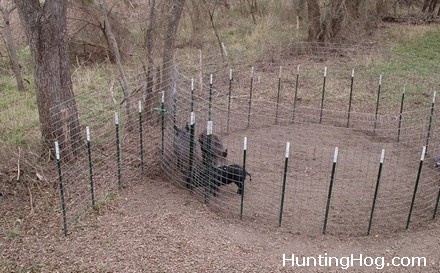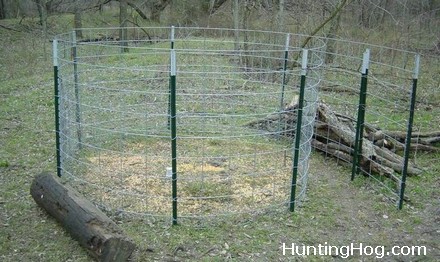
Go Corral Hog Trap or Go Home!
The best panel type hog traps are constructed using 20-foot x 5-foot panels with 4-inch x 4-inch square mesh and steel T-posts. This type of panel is preferred over standard mesh “cattle panels” because it will not allow smaller pigs to fit through the mesh. The extra height also ensures that larger hogs are unable to climb out of the trap. Shorter 4-foot tall panels may allow some trapped hogs to escape. These panels also reduce damage to the hog’s nose, face, and mouth while in the trap.
As with box traps for feral hogs, many different door designs are available for corral traps. The best design for your management efforts depends upon available time, the number of hogs present, the degree of labor required, and material cost. Large sounders are seldom trapped using small traps, and hogs that escape or are not captured may become wary of encountering them in the future. While small traps do catch hogs of all sizes when limited space prevents using larger traps, they are not the most effective method for capturing a large number of hogs. For these situations, a large teardrop-shaped trap is best.
The Cattle Panel and T-Post Hog Trap
Corral traps are very versatile, and their use can be adjusted depending on the situation. Some trap designs do not require a gate or door. These designs function similar to a minnow trap used to capture fishing bait, but they are not very effective in catching trap-shy hogs. Animals that are not captured may become wary of such traps in the future. In addition, loading captured hogs onto a trailer is more difficult than with other layouts.

Pre-Baiting for Hog Trapping Success
Pre-baiting is critical in the use of all feral hog traps. The trapping of hogs is a process, not an event, and pre-baiting is necessary to attract animals and accustom them to entering the trap itself. Bait should first be placed around the gate and within the trap interior. Continue pre-baiting until feral hogs are consistently feeding on the hog bait and entering the trap. Finally, before setting the trap, place bait all the way to the trigger at the back of the trap. However, do not place bait directly on the tripwire, as this may cause the gate to be triggered before animals reach the back of the trap, preventing the capture of some animals.
Hog Trapping Tips
- Place hog traps on or next to existing hog trails.
- Coordinate with your neighbors to share trap gates.
- Always make traps as strong as possible.
- Camouflage pig traps if dealing with trap-shy hogs.
- A game camera can help identify the number of hogs and other species entering the trap and suggest the optimal time to set the trap.
- Pre-bait traps with the door open, and once hogs are routinely entering the trap, then set it.
- Do not put bait outside the trap; make hogs enter the trap in order to get the bait.
- Souring corn in water will help avoid attracting non-target animals, such as whitetail deer.
- Alternate bait types if necessary.
- If possible, check traps from a distance. Avoid leaving any human scent in the area, especially if you are dealing with trap-shy hogs.
- Check traps regularly. Daily inspections are recommended in hot weather.
- Install a visible warning sign that explains trap safety.
- Hog trapping takes patience, so be persistent.
Can i leave the door pinned open for a few days to let the pigs become used to it and would it help capture more pigs?
Kyle, it will definitely help if you keep the door open. Research has found that it takes at least 10 days before mature hogs will trust a trap enough to go inside. If you just set the trap and walk away you are much more likely to capture a young hog or two, if any at all. Building trust is part of catching more or at least older hogs.
Thanks for the article, going to be starting construction on two of these here in the next week or so. We’re getting overrun here at our place in north Texas this year. How many t posts do you recommend using per 20ft section of panel? Also what guage of panel would you recommend? Most of our pigs here are 50-150lbs but ive seen two or three that are pushing 250. Thanks.
Kyle, I would recommend 4 t-post per 20 foot panel. The best type of panel would be a 4″ x 4″ panel, so that smaller pigs do not get away. It’s more expensive up front, but will result in more catches and hold up better down the road. Good luck!
How do you set the door up to close when the hogs are in the trap.
Kenny, I like to prop a stick of about 8-10 inches in length to keep the door open. A big hog will open the door enough so that is closed behind. You can also prop a larger stick and then use a trip-wire about 6 inches off the ground within the trap to pull the stick out. If you go this route then you can use a larger prop stick.
Can we use the second picture in a University of Florida trapping document?
Beth, feel free to use any photos that you like.
We use the 20-foot by 5-foot panels on my uncle’s farm. We will put several together and have caught close to two dozen at a time!
We are ate up with hogs. Caught a few, but now they are trap shy. Have baited with everything, know what do I do now?
Charlie,
Feral hogs are very smart animals. Research has found that it takes adult hogs about 2-weeks to trust a trap. The older hogs must watch younger hogs go in and out of a trap for about 10-14 days before they will go in themselves. Keep your traps open and put a camera on them to monitor hog behavior. Ideally, it would be best to have a remote trigger but these are expensive. So, once you have hogs coming in regularly you may have to get in a box blind or ladder stand to close the door manually.
How deep do you put the posts in the ground when building the trap?
Luis, I recommend putting them in as far as you can. Loose, sandy soil will allow you to put them deeper into the ground, and you should. In tighter clay or rocky type soils then just go as far as you can. If it’s easy to put in it will be easy to pull out, so keep that in back of your mind.
How should I setup something like this to keep deer from entering? Only thing I know of is to mix the corn with diesel fuel. Deer won’t touch it but the hogs will. Any other suggestions?
Mathew, the deer will of course jump in an can jump back out, but you will have to take other measures to keep the deer from eating your hog bait. You may consider putting some wide straps/mule tape or ropes across the top of the trap to confuse deer. They don’t have great depth perception, so this may be enough to keep them from jumping in.
This is Sarah of FN Home guard Co., Ltd, we are the manufacturer of different types of animal catchers, additionally it can also work with alarm-which can send u message or call you directly.
If you need our catalogue or have any question, please feel free to contact me. Thanks!
Sarah
Old VHS tapes are great for keeping deer out/away from a trap; or a garden for that matter. Pull the tape out of the cartridge and tie it loose enuf that it can blow in the wind. Deer react to the tape the same way they do to a snake and bug out. For garden use start at 1 foot or so off the ground and jump up in 18 to 24 inch increments, to about 5 ft off the ground, for the best results. Just at the top of pig traps. you have to leave the tape loose enuf to move around a bit, as was mentioned above, deer don’t have great depth perception and the moving of the tape keeps them spooked.
Bill, thanks for sharing this tip with other hog trappers out there. Keep deer away from traps helps in many ways, and this is a good way to use some of those old VHS tapes we all have tucked away.
What bait is the most efficient?
Patrick, it’s hard to go wrong with sour grain. Get some corn, rice, any grain you can get on the cheap. Fill a 5 gallon bucket up about half way with the grain. Then, fill the bucket up with water to near the top. Let it sit in the sun for a couple days, then you can place the bait in the trap. You can also buy or create a trough by cutting up a plastic barrel, then assembling and leaving everything in trap, as the bait can ripen up in the trap. Once the grain starts fermenting the hogs will not be able to resist it.